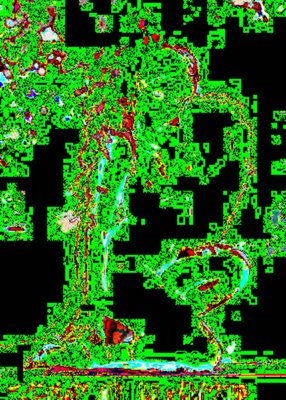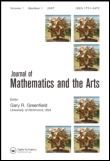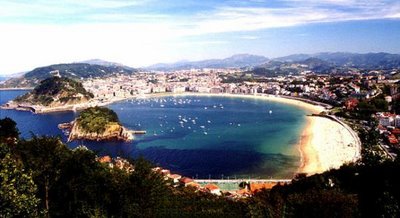Tuesday, February 13, 2007
Monday, February 12, 2007
Marko Niemi Divine Intervention
Posted by
Kaz Maslanka
at
2:26 PM
0
comments
![]()
Labels: Marko Niemi, mathematical visual poetry
Saturday, February 10, 2007
Marko Niemi Eye Of The Beholder
Posted by
Kaz Maslanka
at
11:13 AM
0
comments
![]()
Labels: Marko Niemi, mathematical visual poetry
Wednesday, February 07, 2007
Marko Niemi Party-NRJ
Posted by
Kaz Maslanka
at
7:31 PM
1 comments
![]()
Labels: Marko Niemi, mathematical visual poetry
Tuesday, February 06, 2007
Quote From Samuel Johnson
I am always sorry when any language is lost, because languages are the pedigrees of nations. -Samuel Johnson, lexicographer (1709-1784)
Posted by
Kaz Maslanka
at
12:51 PM
1 comments
![]()
Sunday, February 04, 2007
Delineations Between The Aesthetics Of Math And Art
I would like to invite discourse into the construction of these ideas. Everyone is invited to comment. Making these delineations is not an easy task and I feel the statements may evolve. I will address any comments to these statements.
I feel it is very important to understand the differences in the disciplines of art and math so that we can join them in the most creative, clear and meaningful ways.
Delineation #1:
Mathematical truths are discovered Artistic truths are mediated.
Delineation#2:
Mathematicians generally agree on what is mathematically correct. Artists generally have no idea what is artistically correct.
Math illuminates the supportive skeletal structure of thought whereas Art illuminates the metaphoric wind, which blows through that structure.
Science reveals the body of GGod and Art reveals GGod's mind -- or is it the converse?
Delineation#5
Pure Mathematics has no expression for poetic metaphor however; it does provide us a structure that can be used for it.
Artists have an insouciant tendency to get lost in their imagination Mathematicians have an attentive tendency to map their imagination
A mathematical theory seems to come in a flash of intuition before the final product is rigorously constructed. An artistic theory seems to come much after the artwork that has been constructed in a flash of intuition.
Delineation #10
Artistic creations are uniquely invented by individuals.
Delineation #11
Mathematics, among other things, is a language.
Art, among other things, uses language.
.
In science one tries to tell people, in such a way as to be understood by everyone, something that no one ever knew before. But in poetry, it’s the exact opposite. —Paul Dirac
.
Art is the expression of culture.
Pure mathematics is independent of culture therefore, cultureless.
Some of these were published earlier in Bridges proceedings 2002 “Sentences on the Aesthetics of Mathematics and Art” page 256
Posted by
Kaz Maslanka
at
1:41 AM
12
comments
![]()
Labels: math art moment, math is art?, mathematical art, Mathematical Poetry
Friday, February 02, 2007
Unlikely 2.0
This is my first Korean artwork
Dog Dream = Irrationality / Importance
The poem is in the form of an orthogonal space poem
Check out the lastest Unlikely Stories. My latest two pieces are among some wonderful new art/poetry work.
Posted by
Kaz Maslanka
at
10:33 AM
3
comments
![]()
Labels: Dog Dream, orthogonal space poem, unlikely 2.0
Wednesday, January 10, 2007
Temptation At The Asymptote
As you look at the graph of Y=1/x (above) you will notice the values become extremely large as you approach the asymptote where the value of x equals zero. At x = zero the y value becomes infinite (at the asymptote).
We have the same situation when we approach temptation. It gets stronger and stronger as we get closer to the object of our temptation and when you touch your temptation you lose the game. In other words the shorter the distance to your object of temptation the closer you get to the asymptote.
The form of the poem is an orthogonal space poem
Posted by
Kaz Maslanka
at
6:24 PM
5
comments
![]()
Labels: orthogonal space poem, Temptation
Sunday, January 07, 2007
Monday, December 25, 2006
Flaky Pie
Posted by
Kaz Maslanka
at
10:19 PM
5
comments
![]()
Labels: Pi
Thursday, December 21, 2006
Monday, December 18, 2006
Lothar Schmitz
 Lothar Schmitz’ sculptures reconfigure and question corporate landscape elements using man-made materials. His topiary-like treatment of landscape alludes to the accelerating pace of ecological change and genetic mutation. He draws experience from both his art and physics background. Schmitz is a past Los Angeles Cultural Affairs COLA Individual Artist Grant recipient and a physicist.
Lothar Schmitz’ sculptures reconfigure and question corporate landscape elements using man-made materials. His topiary-like treatment of landscape alludes to the accelerating pace of ecological change and genetic mutation. He draws experience from both his art and physics background. Schmitz is a past Los Angeles Cultural Affairs COLA Individual Artist Grant recipient and a physicist.
FOR IMMEDIATE RELEASE:
CONTRARY TO THE LAWS OF NATURE
Los Angeles based artists stretch those laws and present some of their own.Mitchell Friedman, Manfred Menz, Lothar Schmitz, Carrie Ungerman and Melinda Smith Altshuler address social, environmental and psychological circumstance in the landscape. Exhibition Dates: December 21, 2006 - January 27, 2007Artist’s Reception: Thursday, December 21, 5:30 pm – 7:30 pm
Sarah Lee Artworks & Projects
2525 Michigan Avenue (Bergamot Station), T1, Santa Monica, CA 90402
Media Contact: Melinda Smith Altshuler, 310 367.5246, msasees@yahoo.com
Gallery: 310 829.4938 E-mail, saralee4@verizon.net
Website: http://www.sarahleeartworks.com
Gallery hours: Tuesday through Saturday 10:30 am- 5:30 pmPlease direct e-mail inquiries about the exhibition to the gallery’s address (above);
Posted by
Kaz Maslanka
at
10:23 PM
0
comments
![]()
Sunday, November 26, 2006
Celebrate The Tenth Annual Bridges Conference
Celebrate the Tenth Annual Bridges Conference
BRIDGES DONOSTIA
Mathematics, Music, Art, Architecture, Culture
***************************************
**** http://www.bridgesmathart.org ****
***************************************
Bridges: Mathematical Connections in Art, Music, and Science
School of Architecture, The University of the Basque Country
San Sebastian (Donostia), Spain
July 24-27, 2007
The conference consists of a 4-day combination of Bridges Conference
activities (July 24, 26, and 27) and an excursion day to Bilbao (July
25). Please visit the Announcement page at the conference website for
a complete announcement.
THE CONFERENCE
The Bridges Conferences, running annually since 1998, bring together
practicing mathematicians, scientists, artists, educators, musicians,
writers, computer scientists, sculptors, dancers, weavers, model
builders in a lively atmosphere of exchange and mutual encouragement.
Important components of these conferences, in addition to formal
presentations, include hands-on workshops, gallery displays of visual
art, working sessions with artists who are crossing the
mathematics-arts boundaries, and musical/theatrical events in the
evening.
CALL FOR PAPERS
You are invited to submit either a short (two pages) or long (at most
eight pages) paper that presents new work within the scope of the
Bridges conference. Papers must be submitted as Microsoft Word or PDF
to papers@bridgesmathart.org. The deadline for paper submission is
Febrary 1, 2007. This deadline is firm! If electronic submission is
impossible, please contact Reza Sarhangi to make other arrangements.
Authors will be notified of acceptance on March 25, 2007, and final
papers will be due on April 23.
WORKSHOPS
There will be several teacher workshops for K-12 teachers and educators
at the 2007 Bridges Conference. If you are interested in making a
presentation in one of these workshops you need to submit either a
short (two page) or long (eight page) paper; The deadlines for
submissions of preliminary and final versions are the same as for the
contributed papers.
VISUAL ART EXHIBIT
At the conference, there will be an exhibition room for 2D and 3D
mathematical art, ranging from computer graphics to quilts to
geometrical sculptures. This art exhibit will be curated by Robert
Fathauer. All submitted artwork will undergo a refereeing process.
There is a limit of five submissions per artist. Images of accepted
artworks will also be published on the conference CD.
CONFERENCE REGISTRATION
There is a registration fee of US $180 that includes a copy of the
Proceedings. Extra proceedings will be available during the conference
with a price of US $50. There is a special discounted rate for
students, artists whose expenses are not otherwise supported, and K-12
teachers. Please visit the Registration page at the conference
website.
ACCOMMODATION AND FACILITIES
Participants have a choice of staying in the campus facilities
(comparable to a three star hotel and within walking distance of the
conference site) or staying in a nearby hotels (a list of hotels is
provided in the Accommodations section of the Bridges website).
MAILING LIST
You have received this message because you are subscribed to a mailing
list for Bridges-related announcements. If you would like to manage
your subscription, please visit the mailing list web page at
https://lists.uwaterloo.ca/mailman/listinfo/bridges.
Anyone interested in joining the list may send email to
bridges-join@lists.uwaterloo.ca.
OTHER INQUIRIES
For any other information not available on the web page please
contact: Reza Sarhangi, Department of Mathematics, Towson University,
8000 York Road, Towson, MD 21252, (410) 704-4922. rsarhangi@towson.edu.
Posted by
Kaz Maslanka
at
12:20 AM
1 comments
![]()
Thursday, November 16, 2006
Alligator Cubed
Presently, Dan Waber has some interesting math-poetry related images on his Blog that I would like to draw to attention. There is an interesting series of works by Mirela Roznoveanu that I would like to note, have verbogeometric properties. Although the pieces are not explicitly mathematical (they do not show equations) they do show graphic ideas in space implicitly related to a Cartesian coordinate system.
Because they are so abstract they can have numerous contexts applied to them pointing to meanings just as numerous. The resultant aesthetic experience is a vector sum of all the contexts applied. Of course this is my personal take on this and I will certainly give you room to express your own viewpoint.
 Alligator Cubed by Jeff Crouche
Alligator Cubed by Jeff CroucheThe other piece I want to point out is Jeff Crouche’s “Alligators cubed” This is a perfect example of visual mathematical poem. (a nice one at that)
Posted by
Kaz Maslanka
at
10:27 PM
0
comments
![]()
Wednesday, November 08, 2006
Applications For Verbogeometry

Shown above is a three-dimensional verbogeometric polyhedral
Applications for Verbogeometry
Neal Goldman, a mathematician has come up with a single verbogeometric polytope to analyze huge amounts of data. Business week online has recently published an article talking about Goldman’s polytope and you can access this article here. I was proposing someone write a polytope poem in my blog entry on August 14, 2006. Goldman’s polytope is not a poem but it can be viewed as a hyper-dimensional verbogeometric structure.
I would like to present an excerpt from the article to arouse your curiosity:
How do you convert written words into math? Goldman says it takes a combination of algebra and geometry. Imagine an object floating in space that has an edge for every known scrap of information. It's called a polytope and it has near-infinite dimensions, almost impossible to conjure up in our earthbound minds. It contains every topic written about in the press. And every article that Inform processes becomes a single line within it. Each line has a series of relationships. A single article on Bordeaux wine, for example, turns up in the polytope near France, agriculture, wine, even alcoholism. In each case, Inform's algorithm calculates the relevance of one article to the next by measuring the angle between the two lines.
Here is the link to the original article from business week online
Posted by
Kaz Maslanka
at
12:06 AM
0
comments
![]()
Labels: Verbogeometry
Sunday, November 05, 2006
Journal of Mathematics and the Arts

I would like to spotlight a new Journal on Mathematics and Art. Edited by Professor Gary R. Greenfield from the University of Richmond in Virginia … I will keep you posted when the first issue comes out.
Posted by
Kaz Maslanka
at
11:26 PM
0
comments
![]()
Saturday, November 04, 2006
Upcoming Show in Chicago

For over twenty-five years, PHSColograms, the integration of photography,holography, sculpture, and computer graphics, have created a post-canvas three-dimensional medium that has expanded the visual imagery of the work of a variety of scientists, mathematicians, engineers, architects, and artists.
Paradox. The vessel is a metaphor of our human existence, the body symbolized as a box or bowl is the vessel for the soul. The paradox between the need to belong and the need for individuality; attraction and repulsion; the inside and the outside; materiel expansion and contraction.
Paul V. Galvin Library, Illinois Institute of Technology
35 West 33rd Street, Chicago, IL 60616
Exhibition hours: Monday - Thursday: 12 - 6 pm, Friday: 12 - 5 pm
Saturday: 8:30 am - 5 pm, Sunday: 2 - 6 pm
Posted by
Kaz Maslanka
at
10:45 AM
0
comments
![]()
Sunday, October 29, 2006
Bridges London Conference Proceedings

I just received my Bridges 2006 Conference Proceedings today! It is full of wonderful papers for which some of them I plan to review. I recommend you going down to your local bookstore and ordering it! ISBN 0-9665201-7-3
Posted by
Kaz Maslanka
at
9:02 PM
0
comments
![]()
Friday, October 27, 2006
Tuesday, October 24, 2006
New Design For My Main Website

I have redesigned my main website with an attempt to make the navigation easier. Any feedback will be greatly appreciated!
Thanks!
Posted by
Kaz Maslanka
at
12:39 PM
0
comments
![]()
















